Karst phenomena of Biokovo
A beautiful view of the sea, promontories, and islands, perfectly enjoyed from the above, was almost the sole award for our efforts -Alberto Fortis wrote in his famous work "A Journey Through Dalmatia" in 1774, after a long and almost perilous climb of Biokovo in search of natural ice-pits. At the time of his travel, hiking trails at Biokovo were rare, as rare as the enthusiasts climbing with great efforts until they finally experienced a unique view from Biokovo of the seas and islands as the sole award for their efforts. Besides the hiking trails, Biokovo can today be approached by car, so more and more visitors of Makarska rivi-era choose to visit this mountain. But was the unique view of the sea and islands really the sole "award" to visitors?
For the local population, the Karst landscape of Biokovo is part of their everyday life so,as it often happens, they don't perceive the real value of something that is "right under their nose".
However, for visitors from the Alpine countries, 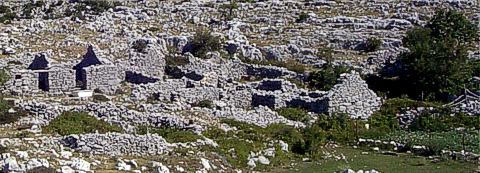 Pannonian planes, urban environments of the Western Europe and alike, the landscape of Biokovo is not part of their everyday life, and many of them will wonder what are those marvelous rocks on Biokovo, what is the origin of unusual depressions - Karst valleys called vrtaèe in the relief of the central part of the mountain, where grooves called škrape and pits come from..., questions about flora and fauna, and about the history of the mountain will follow...
Pannonian planes, urban environments of the Western Europe and alike, the landscape of Biokovo is not part of their everyday life, and many of them will wonder what are those marvelous rocks on Biokovo, what is the origin of unusual depressions - Karst valleys called vrtaèe in the relief of the central part of the mountain, where grooves called škrape and pits come from..., questions about flora and fauna, and about the history of the mountain will follow...
Biokovo offers countless valuable "awards" to inquisitive lovers of nature, but on this occasion I will note only part of Karst phenomena that are being researched or have already been listed among the educative features of Biokovo Natural Park.
Teaching the visitors on the significance and value of the natural beauties of Biokovo is also an important feature of its protection, as the protection of nature is much more efficient when people get to know it directly and experience it in person.
WHAT IS KARST AND KARST PHENOMENA
Rain and snow falling on Biokovo in winter months absorb carbon dioxide out of air and soil, turning it into weak carbonic acid. A consequence of their effects on soluble rocks (limestone and dolomite) of Biokovo through long geological periods is the forming of a special surface and underground relief called Karst.
As watercourses sink through cracks very fast, there are no surface flows in Karst, which is one of its basic features, instead there are subterranean water flows dissolving rocks and expanding cracks and in that way forming numerous caves and pits. Karst relief covers approx. 50% land surface of Croatia. Biokovo is a mountain on which almost all typical Karst phenomena are present.
Karst relief covers approx. 50% land surface of Croatia. Biokovo is a mountain on which almost all typical Karst phenomena are present.
EDUCATIVE GEOLOGICAL PATH BENEATH VILOVIK
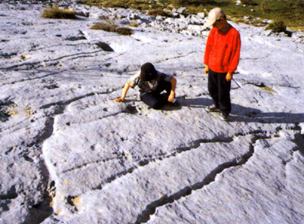
The geological path is located near the area marked on topographic maps as Vilovik, starting at the road leading from the entrance to Biokovo Natural Park towards the highest peak of Sv. Jure (St. George), about 1 km behind Lemišini doci.
The path is short (20 min easy walk), marked with geological marks, and boards on each site, explaining in simple words the origin of limestone, rock that for the most part constitutes the mountain of Biokovo, and part of surface Karst phenomena - škrape and sink-holes -found all around Biokovo.
The origin of limestone is presented in drawings with descriptions in Croatian and English. It encompasses the geological history from the late Jurassic period (approximately 160 million years ago) when mineral skeletal remains of organisms of the former Tethis Ocean settled to the bottom, the sediment hardening into solid rocks, all through to tectonic raising of limestone layers above the sea level, when the erosion processes, which are still going on, started to form the mountain.
It is possible to walk across the limestone surface and take a look at a number of geological curiosities, among which are emphasized cracks and sink--holes as the most recent surface Karst phenomena.
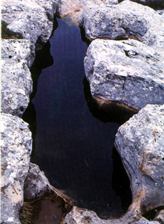 While walking the bare limestone surface, it is possible to see škrape - grooves of various forms and sizes, formed by precipitations draining off down the largest steep and dissolving limestone.
While walking the bare limestone surface, it is possible to see škrape - grooves of various forms and sizes, formed by precipitations draining off down the largest steep and dissolving limestone.
Large ones are formed when several watercourses unite, increasing the speed and creating whirls.
They can be plane, if the surface of the rock is steep, or winding in case of milder slopes. They can be found all across Biokovo.
At the end of the Geological Path, there are some beautiful sink-holes, with a board explaining the origin and significance of this phenomenon on Biokovo.
Sink-holes are round, elongated or irregular cavities in rocks, often with markedly plane bottom. Their diameter is most often ranging from a few centimeters to one meter, rarely a few meters, as is the case with the sink-hole at the Geological Path. They are formed at places where water lingers for a longer period because of milder slope. At first, small caves are formed where water lingers that gradually dissolves limestone. As the dissolution is the most intensive at the point of contact of water surface with rock, sink-holes are gradually being more extended than deepened.
Sink-holes are often "traps" for catching various organic remains from the environment and in time in some of them soil is formed. Large sink-holes in which rainwater accumulates and lingers for longer time are a valuable source of water for cattle watering. For that reason, people often deepened natural sink-holes by carving them to increase their capacity and collect more water. In the large sink-hole at the Geological Path, salamander larvae can be seen as well.
KARST VALLEYS CALLED VRTAÈE
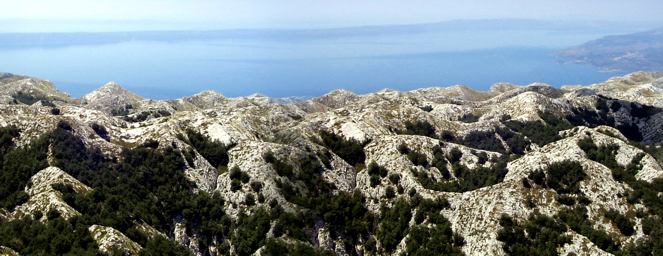 Karst valleys are the largest surface form of the Karst relief on Biokovo. They are usually circular or sub-circular, from a few meters to a kilometer in diameter, and a few meters to several hundred meters deep.
Karst valleys are the largest surface form of the Karst relief on Biokovo. They are usually circular or sub-circular, from a few meters to a kilometer in diameter, and a few meters to several hundred meters deep.
Most of them are on Karst plateaus of the central part of Biokovo, fewer on the slopes, and almost none on steep slopes.
They are formed in complex processes of limestone dissolution at places where concentrated water sinks underground and by fallen-in ceilings of former pits and caves. Valleys formed by gradual long-term dissolution of rocks usually have mild slopes and their bottom is mostly covered with red soil, a mixture of indissoluble remains of limestone and humus. Such valleys are often the only places on Biokovo with soil usable for agriculture, and people use them to cultivate land. People used to remove stones carefully from the bottom of such Karst valleys and arrange them into drystone walls all around, and in that way they would level the surface. Vrtaèe, recessed in relation to the surrounding relief, and drystone walls are an additional protection of fertile soil from winds.
Karst valleys formed by falling in are often with steep sides, with bottom covered with stone blocks falling into a former pit or cave. Along their edges, there are often entrances to parts of caves and pits that are not caved in.
TUÈEPSKA VILENJAÈA CAVE
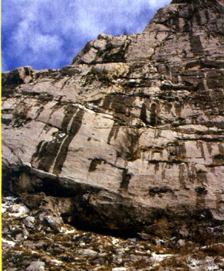 At 1180 m height above sea level, at the foot of an impressive 100 meters high rock, there is a small and secluded entrance to the cave named Tuèepska vilenjaèa. In an amphitheater of vertical limestone rocks, with the view of the sea leaving you breathless, it seems that the location for the cave was chosen by fairies, by which it was named (vilenjaèa - a cave of fairies). According to ancient stories, unusual fairies - beautiful blond girls with horse legs -lived in caves and used to scare passers-by in darkness.
At 1180 m height above sea level, at the foot of an impressive 100 meters high rock, there is a small and secluded entrance to the cave named Tuèepska vilenjaèa. In an amphitheater of vertical limestone rocks, with the view of the sea leaving you breathless, it seems that the location for the cave was chosen by fairies, by which it was named (vilenjaèa - a cave of fairies). According to ancient stories, unusual fairies - beautiful blond girls with horse legs -lived in caves and used to scare passers-by in darkness.
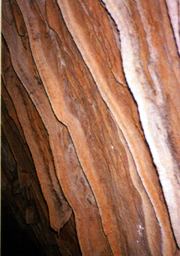
Sunrays find their way only a few meters in the cave, but if we take another step, the sunbathed and familiar external word is turned by a magic stick into the world of eternal darkness shrouded in stone forms.
Hanging above us from the ceiling, are stalactite tubes and thin winding cave curtains, and on the bottom and sides there are large stalagmites, calcite confluences, cascades, cave pearls...
Do you know where all these miraculous stone forms come from? What is their lifetime? Are there living organisms hidden in caves? Why caves of Biokovo are refreshing cold even in mid summer?
You will find answers to these and other questions in an informationrmal conversation and the real setting of Karst subterranean world of Biokovo, if you take an organized tour with a professional guide to the cave, when open for visitors.
Tuèepska vilenjaèa is not a cave arranged for tourists. It can be reached by a hiking trail and you must wear sturdy footwear (most suitable are hiking shoes, but strong athletic shoes are also good), 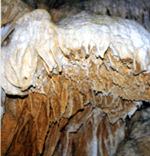 and the cave must be entered with a helmet and the lighting used in speleologic explorations.
and the cave must be entered with a helmet and the lighting used in speleologic explorations.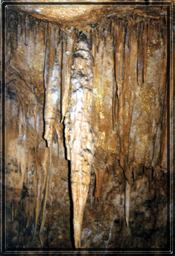 More detailed informationrmation can be obtained at Biokovo Natural Park, Trg Tina Ujeviæa 1/1, Makarska, or at the phone: ++ 385 (0) 21 616 914.
More detailed informationrmation can be obtained at Biokovo Natural Park, Trg Tina Ujeviæa 1/1, Makarska, or at the phone: ++ 385 (0) 21 616 914.
For a tour of the cave, you will need a professional guide, as the entrance is closed to protect it from devastation.
The educative geological path beneath Vilovik and the Tuèepska vilenjaèa cave are just some of the most significant Karst phenomena that are to be presented to visitors of Biokovo Natural Park after the fashion of popular science.
The explorations are in progress, following which the next educative geological path is to be defined in the top part of the mountain, for presentation of Karst valleys, Amfora pit - the deepest pit of Biokovo, and ice-pits.
AMFORA PIT
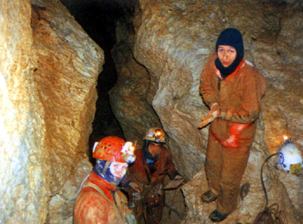
Amfora Pit is located not far from the peak of Biokovo. It was explored in the course of the last few years, and in the last year speleologists descended to the depth of 614 m, which is so far the maximum reached depth on Biokovo.
ICE-PITS
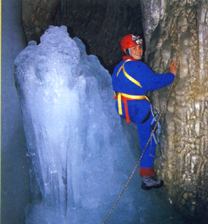
Ice-pits are known as a source of ice that was used to preserve food at the time when there were no refrigerators. They are everywhere around Biokovo. This phenomenon is also known on all the other high mountains in Croatia and in the Alps. Because of large entrances mostly turned towards north, large quantities of snow accumulate in winters in such pits, not managing to melt in summer or alternatively melting and freezing, original snow turning into ice.
Taking ice out of pits of Biokovo was an extremely difficult and dangerous work. In order to reach the ice, people often had to conquer vertical rocks. Temperature in ice pits does not exceed 0 °C even in the hottest summer, and brave icemen were always facing the risk of pneumonia for large differences between temperature on surface and in a pit.

